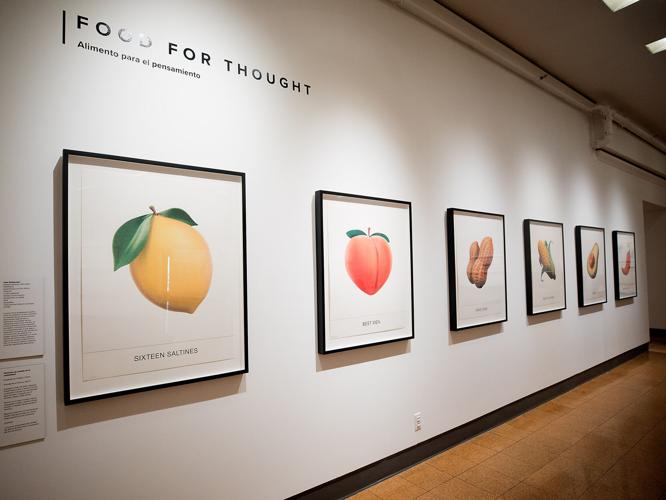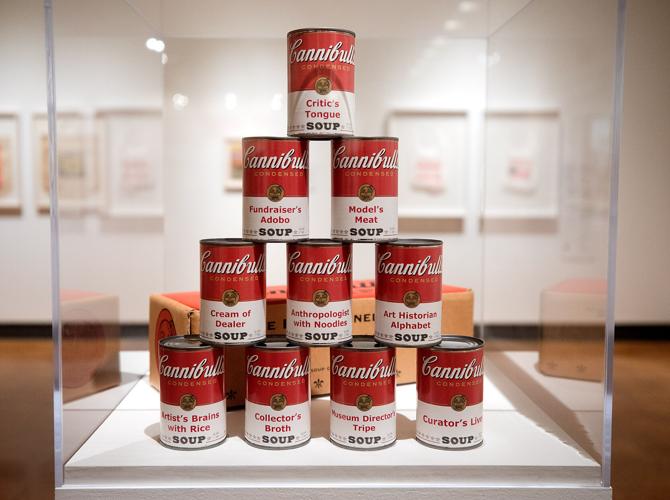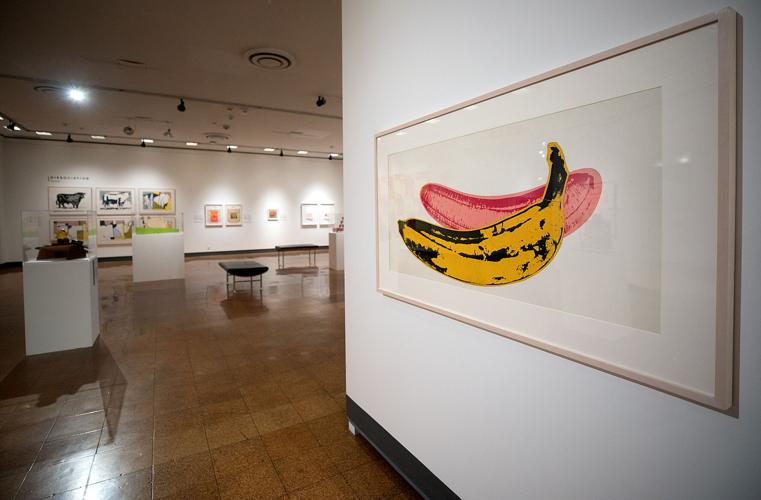The University of Arizona Museum of Art is reopening Sunday with an exhibit that explores a topic every person can relate to: food.
“The Art of Food,” which will remain open through March of next year, features 109 works of art by a wide variety of post-World War II artists, including Andy Warhol, Roy Lichtenstein and Damien Hirst.
It’s the largest exhibit the museum (1031 N. Olive Road at East Speedway), which shut down in-person operations when the pandemic started in March 2020, has ever hosted. Each piece engages the theme of food — how we make it, how we consume it, and how it shapes society — in some way.
In one of the white-walled exhibit rooms, a plaster and enamel sculpture of an indented stick of butter called “Butterscape” by Malia Jensen sits in a glass vitrine. Onlookers are invited to consider its imperfections and the role of butter beyond its mundane purpose as a kitchen staple. On the other side of the room hangs a gelatin silver print called “C-Ration” by Lorna Simpson, which underscores food’s place in America’s history of racism. The words “not good enough” are printed on a picture of a paper dinner plate; Right next to it is a picture of a Black woman’s chest stamped with the words “but good enough to serve.”
“All of the artists in this show are artists of our time. The themes in this exhibition are all themes of our (living) generations,” said Jordan D. Schnitzer, a real estate investor, philanthropist and prolific art collector who loaned the museum all of the pieces used in the exhibit. Simpson’s piece, for example, “sums up the hypocrisy, white supremacy and racial issues we have in this country,” he said. “You could write a 20,000-word essay about that, and nothing says it better than that piece.”
Schnitzer, who first started collecting art as a teenager growing up in Portland, Oregon, now has 19,000 pieces of art in his collection. In his view, nature and art are the only reprieves humans have from the chaos of the modern world.
A few years ago, while he was visiting Tucson for business, Schnitzer met with the staff of the UA’s art museum and he and his Family Foundation offered to loan some of his artwork, free of charge, for an exhibit.
Olivia Miller, who curated “The Art of Food,” took him up on the offer. In 2018, she traveled to Portland to take a look at Schnitzer’s collection and gather inspiration.
“The theme of food just kept coming back to me. There were hundreds of works depicting food. We could do this show two more times and still not repeat any of the artwork from his collection,” Miller said.
She settled on that theme for several reasons, not the least of which are Tucson’s designation as a UNESCO City of Gastronomy, the UA’s involvement in cutting-edge food science research and the prevalence of food insecurity in Tucson.
Moreover, as a university art museum, “every exhibition we approach we really strive to do it with the goal that as many people as possible from across campus will come see it,” Miller said. “We try to have exhibitions that give us the chance to do interdisciplinary programming, and give us the chance to engage with faculty and staff from different departments. And food is such a ubiquitous topic that it was kind of the perfect subject to do that.”
Visitors will also notice QR codes labeled “community food stories” attached to some of the informational panels. Scanning the code with a smartphone reveals another, local dimension to the exhibit.
“We knew the collection coming from Jordan in Oregon would not have a direct connection to Tucson, so as educators we wanted to make that direct connection,” Chelsea Farrar, curator of community engagement, said.
In preparation for the opening, which was delayed by one year because of the pandemic, museum staff reached out to people with a known connection to food, including food writers, educators and food bank workers. More than a dozen Tucsonans were asked to pick one of the pieces in the exhibit that resonated with them and write an essay, poem, recipe or other response.
“It was really personal and diverse,” said Farrar, who added that some of the community responses illustrated the broad range of emotional connections people have with food. “The only people who responded through recipes were people directly involved in service, either working with K-12 students or community food banks. You think of disparity as their work, but really they love food and they see it as a place of healing.”







